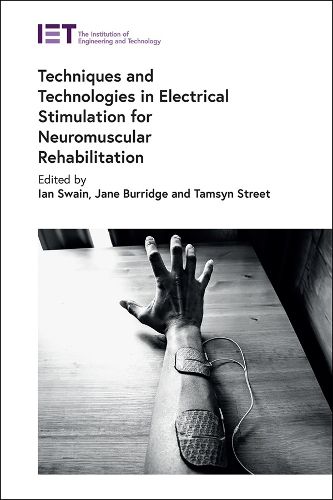Readings Newsletter
Become a Readings Member to make your shopping experience even easier.
Sign in or sign up for free!
You’re not far away from qualifying for FREE standard shipping within Australia
You’ve qualified for FREE standard shipping within Australia
The cart is loading…






In its simplest form, electrical stimulation is the application of electrical impulses to nerves via electrodes placed over the nerve or muscle or implanted within the body. The aim is to evoke a muscle contraction. People may not be able to activate their own muscles sufficiently to execute effective movement due to damage to the nervous system preventing the signals from the brain reaching the muscles, for example, after a stroke or spinal cord injury, or due to disuse, often because of pain. Electrical stimulation can be used to restore or improve impaired function by initiating or complementing muscle activity. Stimulation can be used either to provide exercise and so improve strength and endurance or timed to a physical activity such as walking to improve quality of movement and function.
Over the last twenty-five years electrical stimulation has moved from a research technique to an evidence-based clinical modality. Early applications were limited to the treatment of drop-foot and loss of upper limb function. However, advances in technology, understanding of neural recovery and clinical evidence have opened applications to treat a wide range of conditions, such as pressure sores, bladder, bowel and sexual dysfunction, spasticity and lower motor neuron damage. The reader is taken from the history of therapeutic electrical stimulation, through the physiology that underpins its use, to practical guidance in clinical applications and the regulatory issues that need to be considered in the development of new technologies. It presents the research evidence for each application, reflects on new technologies and applications, such as the use of afferent stimulation to increase central and peripheral neural excitability, and provides practical guidance for clinical use.
Techniques and Technologies in Electrical Stimulation for Neuromuscular Rehabilitation brings together experts from the fields of neuroscience, biomedical engineering and clinical research and practice. The non-technical style enables it to bridge the gap between disciplines, making it essential reading for clinicians, researchers, engineers and industrial developers specialising in electrical stimulation technologies. It aims to improve patient access to evidence-based interventions.
$9.00 standard shipping within Australia
FREE standard shipping within Australia for orders over $100.00
Express & International shipping calculated at checkout
In its simplest form, electrical stimulation is the application of electrical impulses to nerves via electrodes placed over the nerve or muscle or implanted within the body. The aim is to evoke a muscle contraction. People may not be able to activate their own muscles sufficiently to execute effective movement due to damage to the nervous system preventing the signals from the brain reaching the muscles, for example, after a stroke or spinal cord injury, or due to disuse, often because of pain. Electrical stimulation can be used to restore or improve impaired function by initiating or complementing muscle activity. Stimulation can be used either to provide exercise and so improve strength and endurance or timed to a physical activity such as walking to improve quality of movement and function.
Over the last twenty-five years electrical stimulation has moved from a research technique to an evidence-based clinical modality. Early applications were limited to the treatment of drop-foot and loss of upper limb function. However, advances in technology, understanding of neural recovery and clinical evidence have opened applications to treat a wide range of conditions, such as pressure sores, bladder, bowel and sexual dysfunction, spasticity and lower motor neuron damage. The reader is taken from the history of therapeutic electrical stimulation, through the physiology that underpins its use, to practical guidance in clinical applications and the regulatory issues that need to be considered in the development of new technologies. It presents the research evidence for each application, reflects on new technologies and applications, such as the use of afferent stimulation to increase central and peripheral neural excitability, and provides practical guidance for clinical use.
Techniques and Technologies in Electrical Stimulation for Neuromuscular Rehabilitation brings together experts from the fields of neuroscience, biomedical engineering and clinical research and practice. The non-technical style enables it to bridge the gap between disciplines, making it essential reading for clinicians, researchers, engineers and industrial developers specialising in electrical stimulation technologies. It aims to improve patient access to evidence-based interventions.